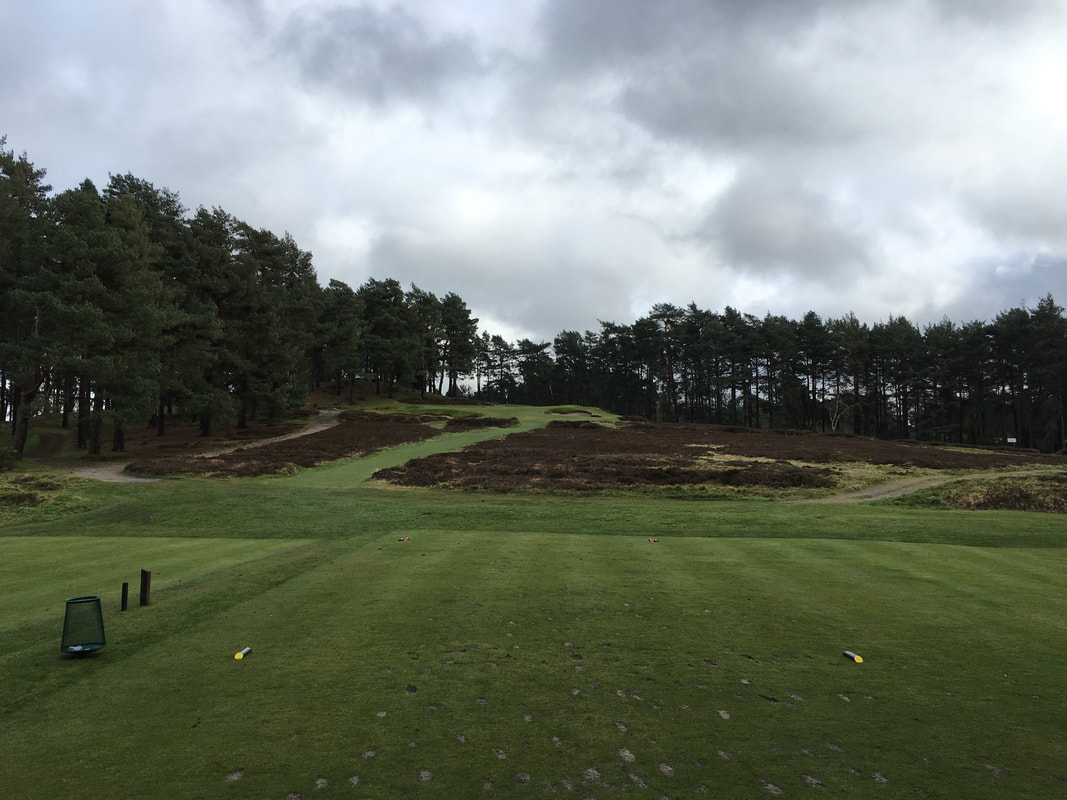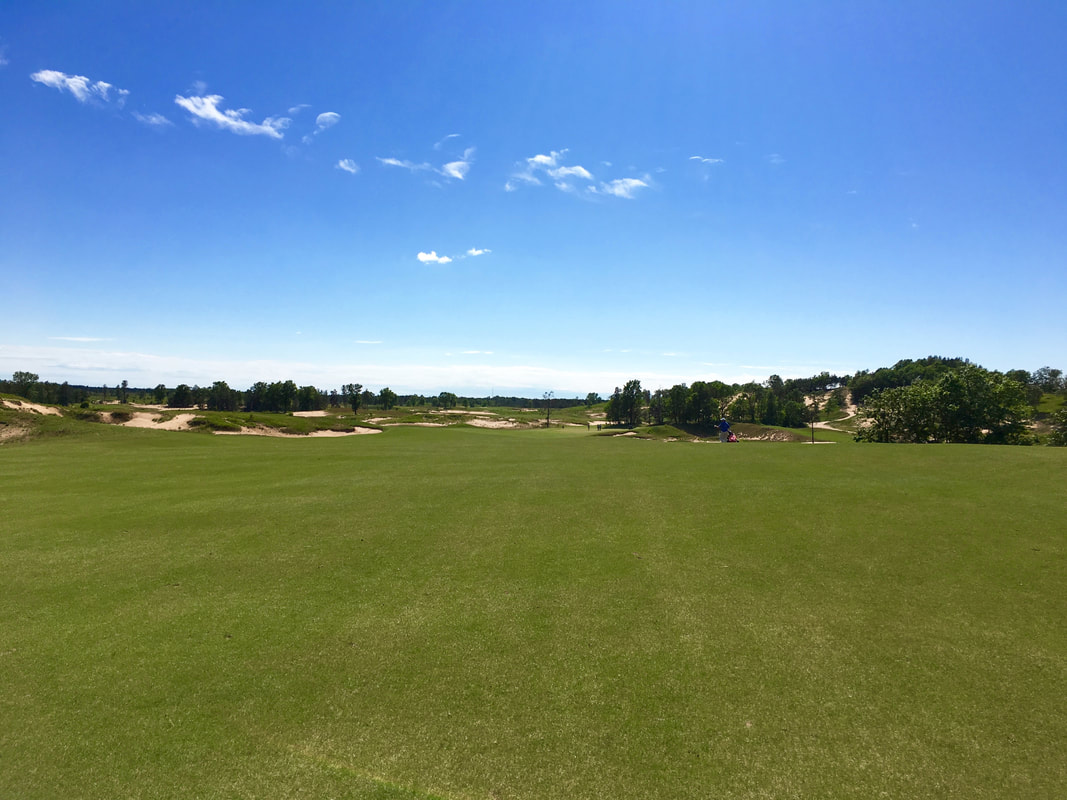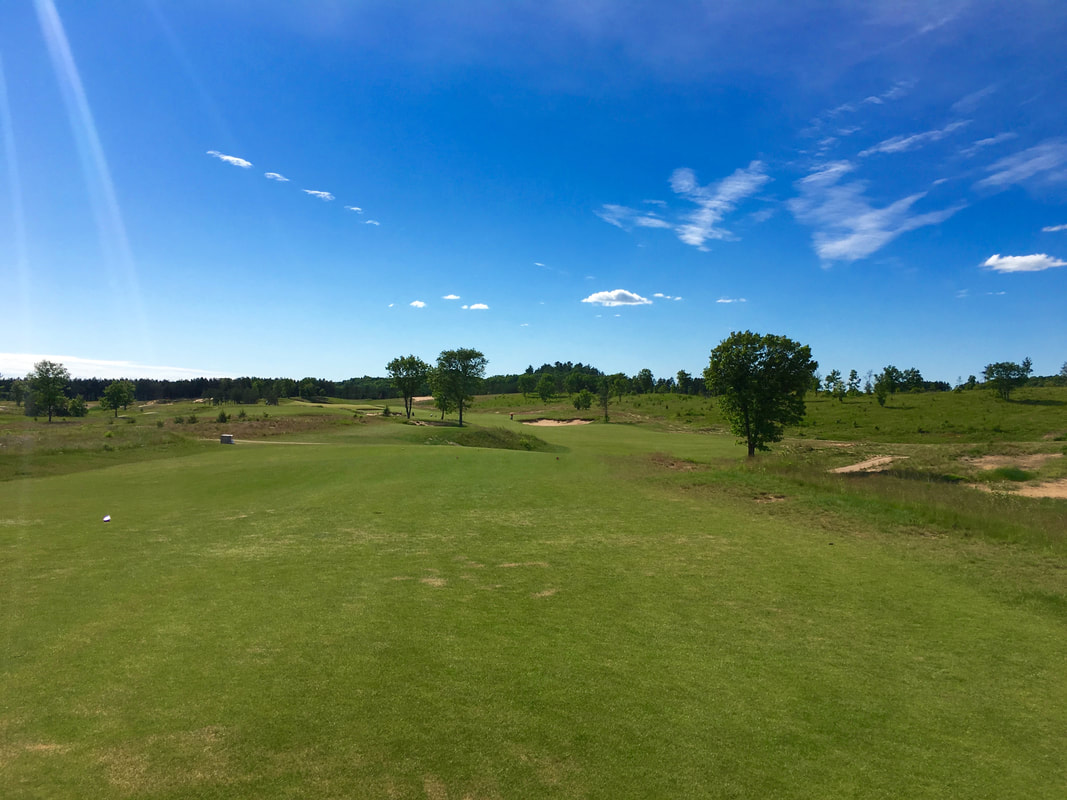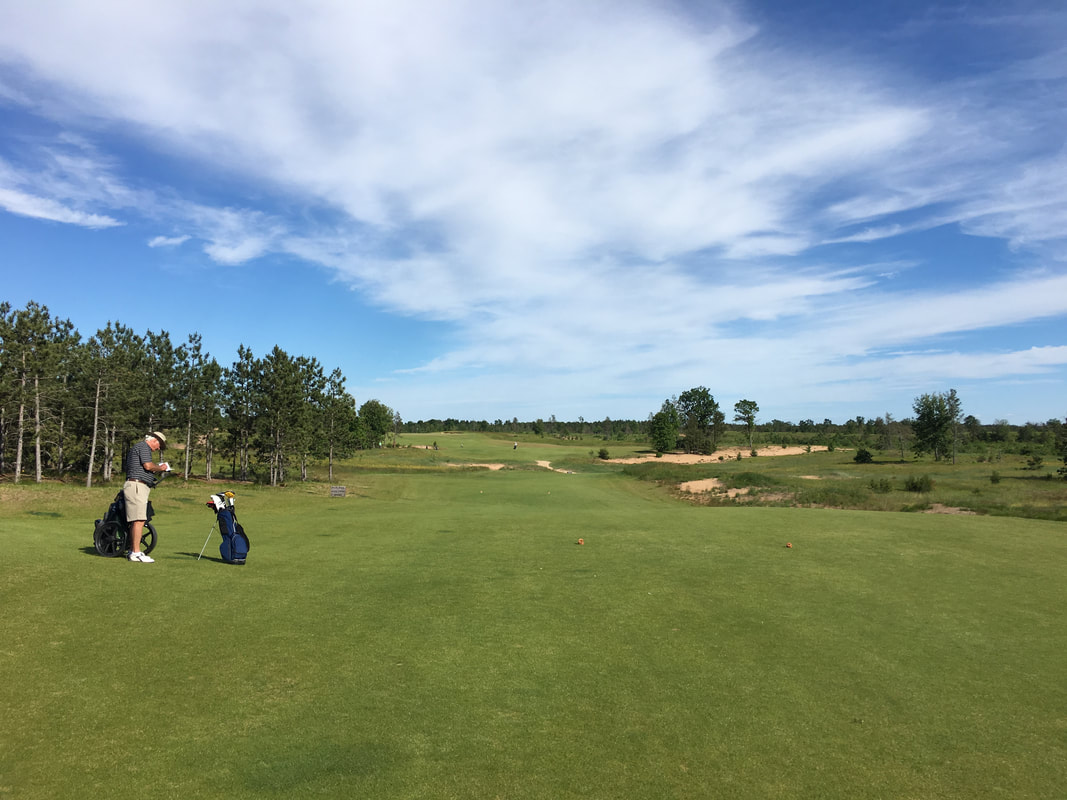I’ve been excited to play Sand Valley ever since I heard that Mike Keiser would be developing a golf resort in the sand hills of central Wisconsin and that Bill Coore and Ben Crenshaw would be designing it, probably seven or eight years ago. As I discussed at the beginning of my Mammoth Dunes review, I was intrigued by this region as great land for golf when I came hiking here back in 2008. When I heard that Mike Keiser thought the same thing and hired Coore and Crenshaw to build the first of several courses here, I knew that I wouldn’t be disappointed.
And I wasn’t. Once they decided to strip away the red pines on what was an old lumber plantation and expose the sand barrens and their native vegetation, it was going to take a special effort to build a bad golf course. I suppose that they could have built one with several blind shots and overly complicated holes, a bit like Tobacco Road. But when you look down from the first/tenth tee, you’ll see that the property is just too pure to do anything fussy like that.
Unlike its younger sister Mammoth Dunes, Sand Valley lets the land dictate the play. Whereas David McLay Kidd did a tremendous amount of shaping to create a variety of mounds and banks that you could use to run the ball onto greens or near tucked hole locations, Sand Valley sits on the land in a simpler way. That means that sometimes the land will help you get the ball closer to the hole. But often it will not. Sand Valley is a tougher course—often a little narrower and a little bit less forgiving around the edges. But there are also several holes with big, concave greens like those on Mammoth Dunes. So there’s a lot of variety in this course, arguably more than on Mammoth Dunes. But easy or hard, it’s still a lot of fun and rewards well-played golf, if not so much creativity.
The first hole is a pretty atypical start: a short, but not drivable par 4 (~330 yards). This type of hole seems to have fallen out of favor recently as we’ve come to equate short and drivable par 4s. But even the juicer would be wise to lay back here as the green is at a sharp front right to back left angle to the tee and any miss left of the fairway will give you an approach that you definitely didn’t practice at the range. So take it easy on yourself—lay-up to the right and pitch on.
And I wasn’t. Once they decided to strip away the red pines on what was an old lumber plantation and expose the sand barrens and their native vegetation, it was going to take a special effort to build a bad golf course. I suppose that they could have built one with several blind shots and overly complicated holes, a bit like Tobacco Road. But when you look down from the first/tenth tee, you’ll see that the property is just too pure to do anything fussy like that.
Unlike its younger sister Mammoth Dunes, Sand Valley lets the land dictate the play. Whereas David McLay Kidd did a tremendous amount of shaping to create a variety of mounds and banks that you could use to run the ball onto greens or near tucked hole locations, Sand Valley sits on the land in a simpler way. That means that sometimes the land will help you get the ball closer to the hole. But often it will not. Sand Valley is a tougher course—often a little narrower and a little bit less forgiving around the edges. But there are also several holes with big, concave greens like those on Mammoth Dunes. So there’s a lot of variety in this course, arguably more than on Mammoth Dunes. But easy or hard, it’s still a lot of fun and rewards well-played golf, if not so much creativity.
The first hole is a pretty atypical start: a short, but not drivable par 4 (~330 yards). This type of hole seems to have fallen out of favor recently as we’ve come to equate short and drivable par 4s. But even the juicer would be wise to lay back here as the green is at a sharp front right to back left angle to the tee and any miss left of the fairway will give you an approach that you definitely didn’t practice at the range. So take it easy on yourself—lay-up to the right and pitch on.
The second is a medium-length par 4 that has one of my favorite types of greens: one where the front is completely open and where a miss short right or left leaves an easy pitch, but one that gets narrower at the back and where the run-offs become steeper and longer the further you go. For some reason, I didn’t get pictures of the sides but safe to say whatever your yardage, play to the front of the green.
After a lovely long par 3 over a big sandy waste area, we come to a long, wide open, uphill par 5. As long and as wide open as it seems, it plays even longer, but not quite as wide. Holes four and five work their way to the highest point on the course so while there’s plenty of room to miss, you’re probably gonna need some of that. You have to hit two good shots to get with a decent distance of the green and the third shot played about two clubs uphill. I was the only one in my four ball still standing by the time that we got to the green…and just barely at that.
The fifth is a drop shot par 3 and a very good one. The green is about twice as wide as it is deep, but it should be plenty deep enough. A miss short right will feed off down a slope, so it’s best to hedge a little left.
Six is a long par 4 where the fairway bunker cutting in on the left should be your cue that it’s best to play your drive up the left side. There’s plenty of room to run your ball up onto the green from the left but this is one hole where, like Mammoth Dunes, you really need to know where the pin is placed. The green is enormous and heavily contoured. But unlike Mammoth Dunes, there are no shoulders on its edge to keep your ball on the green. Like most of the other greens on Sand Valley, the edges are convex so you have to be a bit more careful if you’re playing the ball on the ground.
Seven is another par 5 and, I think, one of the best holes on the course. The drive is up hill and plays diagonally left to right along a large bunker up the right. There’s room to play out to the left but if you go too far, there’s another bunker to catch your drive. This left bunker runs down the hole for another 140 yards and splits the lay-up zone into a blind left side, which gives you a shorter approach and better angle, and an open right one. If you can carry your second to within 110 yards of the green, you can carry this bunker.
The eighth is a great example of one of my favorite type of holes, the uphill par 3. If there were heather around the bunkers, this hole would be at home on one of Colt’s excellent London-area heathland courses.
Nine is a drivable par 4 that features in a lot of the course’s promotional material. It’s a bit simpler than a lot of the drivable par 4s today—the fairway is wide open for a lay-up but the green is surrounded by bunkers, so you either have to run it up the narrow front or carry it to the green. It’s definitely a sucker play because the green is quite receptive and the three of four people in my four ball who laid up were able to get their seconds close to the hole (to be fair, so did the guy who tried to drive the green).
Ten is another excellent par 5—in fact, it’d probably be my pick for the best hole on the course. There’s a b bunker in the middle of the fairway and you’d correctly suspect that if you want to go for the green in two, you should either carry it or play to the narrower fairway left. The second shot is one of my favorite shots on a par 5. About 100 yards short of the green, bunkers left and right pinch the fairway, which plays into the green from a slight left-to-right angle. So if you’ve kept it near the centerline bunker off the tee, it’s a straight shot. If you’ve hit your drive out to the right, the angle into this section of the fairway is awkward. It’s a bit like the second shot on the ninth hole at Lawsonia, but laying up short of the bunkers here only leaves you 120 yards rather than a 170 blind shot. Unfortunately I didn’t get good pictures of the approach to the green.
Eleven is a good example of one of the strengths of Sand Valley: its variety. After a few complex par 5s, this hole is fairly simple. The fairway is wide open but the approach is much easier if you hug the left fairway bunker. That’s because the green has a Pinehurst run-off on its right side—if you miss here, the ball will run down a 4 ft. slope about 20 feet away from the green. If you’re in the right side of the fairway, you’ll have to carry this slope to go at middle or back pins.
Twelve is another very complicated par 5, I think a bit unnecessarily so. The bunker on the right is about 220 short of the green and if you can reach it, you’ll either have to lay-up or play over the edge of the trees on the left. I’m not a long hitter and I managed the latter just fine, so it’s doable. And actually there’s one more option although no one in my group was aware of it—the fairway that you see left of the trees is an alternate fairway. It’s wide open, but I’m not sure anyone hits it over there because it looks like it’s on another hole (although that hasn’t always stopped me before…). The approach from there is blind and has to carry a lot of junk. The approach from the right is straight-forward and if you’ve carried the trees, it’s easy to reach in two (I did it both times with a mid-iron). I’d suggest losing the left fairway and make the driving decision about laying up short of the bunker or carrying/skirting the trees.
Thirteen is medium-long par 4 that is wide open but plays very tough because like the long par 5 fourth, it’s uphill and was straight into the wind. I suspect that this is the prevailing wind because the green is wide open in front, giving you ample opportunity to run it on. Fourteen is a lovely par 3 framed by sand and scrubby pines. The green is receptive in the back for those who go directly at back hole locations.
Fifteen is a medium-long par 4 where you want to hug the let side of the fairway to shorten the approach. While there’s a lot of room to run the ball onto the green, the approach becomes very long if you let your drive leak to the right.
Sixteen is one of the toughest par 4s that I’ve ever played. It ruined my second round and let’s just say, it didn’t make a positive contribution to the first either. There’s a bunker in the middle of the fairway about 190 yards short of the green, right where I wanted to drive my ball. The green is up a hill to the left, protected by a bunker on its right and if you drive right of the centerline fairway bunker, it’s an extremely hard approach. You can run it in up the left, but there are two bunkers cut into the hill short and left of the green, so you have to be very careful with this shot.
The last two holes feel like they belong next door on Mammoth Dunes, but that just contributes to the variety in the course. The seventeenth is a long par 3 to what must be a >10,000 sq. ft. green in a massive punchbowl. For most pin placements, you’ll at best be able to see the top of the flag. It’s pretty easy to hit this green, but difficult to get close to the pin unless you know where it is and which slopes feed toward it.
The eighteenth is a very busy uphill par 5. The best play is just to go right over the middle of the first bunker although long hitters will be able to reach the next one. If you hit a good drive, you should be able to reach the green, but you’ll have to carry the bunker that runs along the right. The more direct a line you take, the more of the bunker that you’ll have to carry. But the green is receptive to a shot that runs in from the left. If you lay up, you’ll need to be sure where the pin is because the green is 60 yards deep from the lay up area.
I found Sand Valley to be several shots harder than Mammoth Dunes. It’s easier to get away with a few loose shots over there. The closing stretch killed me both times that I played this course although with the exception of number sixteen, that’s probably due more to my bad shooting than the difficulty of the holes. And there are also fewer opportunities to three-putt here so if that’s the weakness in your game, you may find Sand Valley to be a bit easier.
Overall, I find Sand Valley and Mammoth Dunes to be two of the tougher courses to rate than I’ve played. The architects put a lot into their designs and they took full advantage of the opportunity for spectacle that the landscape provides. And I guess that if I had one general criticism of both courses, it’d be on this latter point: they’re both a bit too spectacular. It’s hard to criticize something for being too beautiful, but that isn’t really what I mean. I mean more that they’re too spectacular in the sense that they’re visually and often strategically overwhelming. There are probably too many waste bunkers, too many centerline bunkers, and on Mammoth Dunes, the slopes on and around the greens are a bit much. It’s arguably both visual and mental overload and having written these reviews just after I wrote a review of Lawsonia, I think that I’m starting to prefer that course’s approach to design features: the hazards are stark, but limited in number and while there are a few wild greens, many are simpler. There’s a lot of strategy, but it’s neither strategically nor visually overbearing.
It’s also interesting to compare these courses to the Loop in Michigan, with which the property shares some key similarities. While the land here is hillier, both are on all sand and the trees are scrubby Jack Pines and Oaks. The native vegetation seems a bit different here—I didn’t see any prickly pear cactus or beach heather at the Loop. But the main difference is that they left the margins between the holes undisturbed at the Loop while here, everything’s been dug up to expose the underlying sand. It’s certainly more visually spectacular this way and one of my main criticisms of the Loop is that it’s both a bit visually and, off the tee at least, strategically dull at times.
But I think that these course and the Loop would each be a bit better if they borrowed from the other’s approach. The Loop could use a little more visual/strategic interest off the tee while these courses could use less. These courses could also use a bit more short grass and less sand around the greens. I really like the Loop’s greens, which are much smaller in scale and rely more on 2-4 ft. high ridges and mounds. A few simpler greens like those over here would add to the variety. But a few big, wild greens would add to the variety on the Loop. Sand Valley is somewhere in between the extremes of Mammoth Dunes and the Loop, but it’s a lot closer to Mammoth Dunes than the Loop.
Maybe the answer to all of this will be Doak’s third course here, which is currently under construction. While the resort describes itself (accurately enough) as ‘This is heathland golf,’ Doak’s course will take inspiration of another feature common to many of the best courses over there: that the par will be <70. But I hope that Doak’s course takes inspiration from another aspect of those courses: their greater sense of intimacy, with greater simplicity from tee to green and greater use of the native vegetation as rough rather than sand blowouts. It’d be especially nice if they could encourage the growth of the native beach heather, which is very similar to the European heathers common to those courses. That would bring some nice variety to Sand Valley and give golfers probably the closest thing we’d have to heathland golf in the United States.
Overall, I find Sand Valley and Mammoth Dunes to be two of the tougher courses to rate than I’ve played. The architects put a lot into their designs and they took full advantage of the opportunity for spectacle that the landscape provides. And I guess that if I had one general criticism of both courses, it’d be on this latter point: they’re both a bit too spectacular. It’s hard to criticize something for being too beautiful, but that isn’t really what I mean. I mean more that they’re too spectacular in the sense that they’re visually and often strategically overwhelming. There are probably too many waste bunkers, too many centerline bunkers, and on Mammoth Dunes, the slopes on and around the greens are a bit much. It’s arguably both visual and mental overload and having written these reviews just after I wrote a review of Lawsonia, I think that I’m starting to prefer that course’s approach to design features: the hazards are stark, but limited in number and while there are a few wild greens, many are simpler. There’s a lot of strategy, but it’s neither strategically nor visually overbearing.
It’s also interesting to compare these courses to the Loop in Michigan, with which the property shares some key similarities. While the land here is hillier, both are on all sand and the trees are scrubby Jack Pines and Oaks. The native vegetation seems a bit different here—I didn’t see any prickly pear cactus or beach heather at the Loop. But the main difference is that they left the margins between the holes undisturbed at the Loop while here, everything’s been dug up to expose the underlying sand. It’s certainly more visually spectacular this way and one of my main criticisms of the Loop is that it’s both a bit visually and, off the tee at least, strategically dull at times.
But I think that these course and the Loop would each be a bit better if they borrowed from the other’s approach. The Loop could use a little more visual/strategic interest off the tee while these courses could use less. These courses could also use a bit more short grass and less sand around the greens. I really like the Loop’s greens, which are much smaller in scale and rely more on 2-4 ft. high ridges and mounds. A few simpler greens like those over here would add to the variety. But a few big, wild greens would add to the variety on the Loop. Sand Valley is somewhere in between the extremes of Mammoth Dunes and the Loop, but it’s a lot closer to Mammoth Dunes than the Loop.
Maybe the answer to all of this will be Doak’s third course here, which is currently under construction. While the resort describes itself (accurately enough) as ‘This is heathland golf,’ Doak’s course will take inspiration of another feature common to many of the best courses over there: that the par will be <70. But I hope that Doak’s course takes inspiration from another aspect of those courses: their greater sense of intimacy, with greater simplicity from tee to green and greater use of the native vegetation as rough rather than sand blowouts. It’d be especially nice if they could encourage the growth of the native beach heather, which is very similar to the European heathers common to those courses. That would bring some nice variety to Sand Valley and give golfers probably the closest thing we’d have to heathland golf in the United States.




































 RSS Feed
RSS Feed